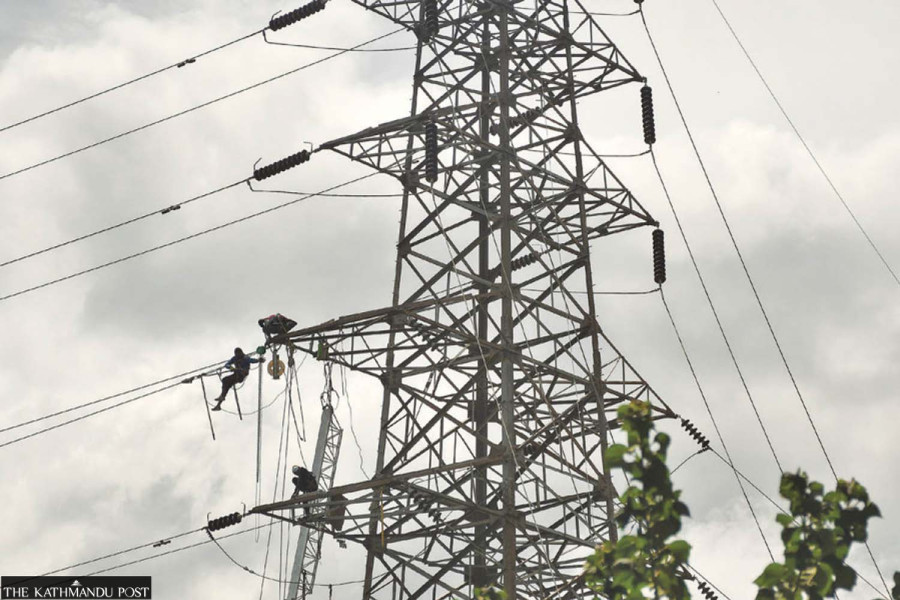National
Power export earns Nepal Rs10 billion
Electricity has emerged as a major earner of foreign currency for cash-strapped country.
Prithvi Man Shrestha
Electricity has grown to be one of Nepal's largest exports over the past year since the southern neighbour, India, opened its doors for Nepal to export power to its market through competitive bidding.
On November 2 last year, India had for the first time allowed Nepal to sell electricity in the Indian market via a competitive bidding process.
Initially, the southern neighbour had allowed Nepal to sell 39MW of electricity produced by the 24MW Trishuli hydropower project and the 15MW Devighat hydel project.
But since early June this year, Nepal has been permitted to sell upto 364 MW of electricity generated by six hydroelectric projects.
“We sold electricity worth nearly Rs10 billion in the Indian market over the past one year after India permitted Nepal to export power to its open power market,” said Lokendra Saud, an official of the finance department of the Nepal Electricity Authority. “We have sold electricity worth around Rs8.5 billion since June.”
However, Nepal has to import power from its southern neighbour during the winter season when its hydel power plants don’t produce enough electricity as per their rated capacities because of reduced water levels in the Nepali rivers.
At present, when compared with other major exports of Nepal, electricity has emerged as one of its top five exports.
The export of soybean oil topped the charts with exports worth Rs48.12 billion in the last fiscal year, followed by palm oil (Rs41.06 billion), yarns (Rs11 billion) and woollen carpet (Rs9.56 billion), as per the data from the Trade and Export Promotion Centre (TEPC), a trade promotion agency under the commerce ministry.
Soybean oil and palm oil are among the least value-added exports of the country.
“We would be able to earn even more, if the prices of electricity had not gone down in recent months,” said Suresh Bhattarai, a spokesperson for the NEA. “The average price that we are getting is just over INR4 per unit.”
When Nepal resumed selling power in India's power exchange market in June, the average price was more than INR 7 per unit,” Bhattarai added.
Experts say electricity exports could contribute to reducing the country’s massive trade deficit, particularly with India.
According to the TEPC, India was Nepal’s largest trading partner and its largest export destination with the Indian market absorbing nearly 78 percent of Nepal’s total exports, excluding electricity, in the last fiscal year.
But the trade deficit with India is huge with the country exporting goods worth Rs155 billion to its southern neighbour as compared to imports valued at Rs1.2 trillion.
Even in the electricity trade, Nepal was in deficit until the last fiscal year with the country importing power worth Rs15.46 billion from India as against the exports worth Rs3.88 billion, according to the NEA.
“As we are struggling to boost exports of other goods to India, electricity exports have shown great hope for Nepal to reduce trade deficit with India,” said Chandra Ghimire, a former commerce secretary. “The more important thing about electricity is that it is a product with one of the highest value additions in Nepal and has had multiplier effects on the economy ranging from generation, transmission and distribution of power.”
“As we expect to earn Rs16 billion this fiscal year from electricity exports and over Rs30 billion in the next fiscal year, electricity will be an indispensable export item for the country,” Kul Man Ghising, NEA’s managing director, had told the Post in September.
Until a few years ago, earning foreign currency in big amounts from electricity exports was a daydream as the country was facing a prolonged load-shedding.
The NEA announced in May 2018 that the country was fully free of load-shedding after ending power cuts for both households and industrial customers.
In October 2014, Nepal and India signed a Power Trade Agreement agreeing to facilitate the sale and purchase of electricity in their respective countries depending on the potential to generate and demand.
In November of the same year, the SAARC Framework Agreement for Energy Cooperation (Electricity) was signed by all member states during the 18th SAARC Summit held in Nepal. SAARC is short for the South Asian Association for Regional Cooperation.
These agreements didn’t yield any results, immediately. But there has been a growing convergence of ideas among the SAARC countries, particularly Bangladesh, Bhutan, India and Nepal (BBIN) to expand cooperation in the area of power trade.
Nepal and India announced the Joint Vision Statement on Power Sector Cooperation in early April during Prime Minister Sher Bahadur Deuba’s visit to India. The statement talked about strengthening cooperation on joint development of power generation projects in Nepal, and the development of cross-border transmission infrastructure and bi-directional power trade with appropriate access to electricity markets in both countries, based on mutual benefits.
The two sides also agreed to expand cooperation in the power sector to include their partner countries under the Bangladesh, Bhutan, India and Nepal (BBIN) framework, subject to mutually agreed upon terms and conditions between all involved parties.
“The moves from the three countries towards electricity trade might provide an avenue to export power to large power markets in India and Bangladesh,” said Ghimire. “Both countries are power hungry. If we move ahead strategically, there is a possibility that electricity might emerge as the largest export item of the country.”
However, officials and experts say that there are multiple challenges to boost power exports.
The first is whether the country would be able to produce enough electricity to increase exports worth Rs70 billion in the next five years as announced by the Energy Minister, Pampha Bhusal.
Nepal Electricity Authority has not signed power purchase agreement (PPA) with the developers of run-of-the-river projects for the last three years.
A Cabinet meeting in June had decided to open the door for signing of the PPA for 1,500MW of energy between the state-owned power utility and power developers. But the decision has yet to be implemented.
Independent power producers say the continued refusal to sign PPA with independent power producers will constrain Nepal’s ability to produce enough power to boost exports.
“We need to produce extra 2,000MW of electricity from the run-of-the-river projects just to be self reliant on electricity, if no storage type project is developed because run-of-the-river projects don’t run in their full capacity during the dry season,” said Mohan Kumar Dangi, vice-president of the Independent Power Producers’ Association of Nepal.
The NEA said it has received PPA applications for more than 11,391 megawatts of electricity so far and the private sector has been demanding that the NEA start signing the agreements.
The lack of high capacity cross-border transmission lines as well as domestic infrastructure could also limit Nepal’s ability to export more power as tagged, according to officials and experts.
There are a dozen cross-border transmission lines between Nepal and India of 33kV, 132kV and 400kV capacities, according to the energy ministry.
Only the Dhalkebar-Muzaffarpur Cross Border Transmission Line has 400kv capacity, which can transport around 1,000MW of electricity. Other 11 cross-border transmission lines can transport power between 5MW and 125MW only, according to a white paper on energy issued by the ministry in May 2018.
Nepal and India have agreed to build another 400kV Butwal-Gorakhpur cross-border transmission line with joint investment. The two countries have agreed to set up a joint venture company in India to implement the project.
The Arun 3 Hydropower Project, which is being developed by the SJVN Limited, an Indian firm, is also building its own dedicated cross-border transmission line between Nepal and India to export electricity generated by the project on the Arun river in eastern Nepal.
NEA officials said that a lack of high capacity transmission lines is one of the major hurdles in boostings exports to India and beyond.
Besides the transmission infrastructure, the private sector hydropower companies have also been demanding that the government allow them to engage in power trading. “It has already been late to bring the private sector on board,” said former secretary Ghimire. “They can explore new buyers and markets and help boost export of power.”
Nepal also has concerns over the Procedure for Approval and Facilitating Import/Export (Cross Border of Electricity) by the Designated Authority introduced by Central Electricity Authority, which has imposed restrictions on trading of power generated by projects involving China.
“Provided the government succeeds in convincing India to remove such restrictions, it would help boost investments in the sector and increase the export of power,” said Ghimire.




 18.12°C Kathmandu
18.12°C Kathmandu















